Range Rover Evoque: Suspension Top Mount
Removal
NOTES:
The suspension top mount is manufactured from mild steel and RP220.
The service panel is serviced not fully spot welded.
The panel is serviced less its weld studs
1. In this procedure, to make sure the vehicle is correctly aligned, it must be placed on an approved alignment jig.
2. The suspension top mount is replaced in conjunction with:
- Front bumper cover
- Front bumper
- Hood
- Hood latch panel
- Front fender
- Fender apron upper panel
- Fender apron panel reinforcement
- Fender apron panel front reinforcement
- Fender apron lower panel
- Instrument panel
- Engine and suspension
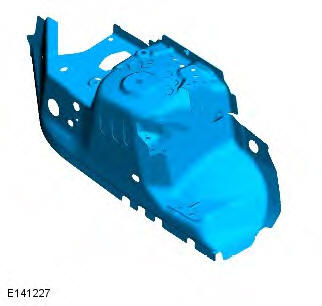
3. For additional information relating to this repair procedure please see the following: For additional information, refer to: Health and Safety Precautions (100-00 General Information, Description and Operation) / Body Repairs (501-25A Body Repairs - General Information, Description and Operation) / Corrosion Protection (501-25B Body Repairs - Corrosion Protection, Description and Operation) / Body and Frame (501-26 Body Repairs - Vehicle Specific Information and Tolerance Checks, Description and Operation) / Standard Workshop Practices (100-00 General Information, Description and Operation).
4. Remove the fender apron panel reinforcement.
For additional information, refer to: Fender Apron Panel Reinforcement (501-27 Front End Sheet Metal Repairs, Removal and Installation).
5. Remove the fender apron panel front reinforcement.
For additional information, refer to: Fender Apron Panel Front Reinforcement (501-27 Front End Sheet Metal Repairs, Removal and Installation).
6. Remove the engine and front suspension as an assembly.
7. Remove the instrument panel.
For additional information, refer to: Instrument Panel - TD4 2.2L Diesel (501-12 Instrument Panel and Console, Removal and Installation) / Instrument Panel - GTDi 2.0L Petrol (501-12 Instrument Panel and Console, Removal and Installation).
8. Remove the front seats.
For additional information, refer to: Front Seat (501-10 Seating, Removal and Installation).
9. Remove the rocker panel inner trim panels.
10. Remove the cowl side trim panels.
For additional information, refer to: Cowl Side Trim Panel (501-05 Interior Trim and Ornamentation, Removal and Installation).
11. Remove the carpet, front section.
12. RH Side: Remove the pedal box.
For additional information, refer to: Brake Pedal and Bracket (206-06 Hydraulic Brake Actuation, Removal and Installation).
13. RH Side: Remove the brake booster.
For additional information, refer to: Brake Booster (206-07 Power Brake Actuation, Removal and Installation).
14. LH Side: Release the battery junction box and position aside.
15. Remove the secondary bulkhead panel.
For additional information, refer to: Secondary Bulkhead Center Panel - TD4 2.2L Diesel (501-02 Front End Body Panels, Removal and Installation) / Secondary Bulkhead Center Panel - GTDi 2.0L Petrol (501-02 Front End Body Panels, Removal and Installation).
16. LH Side: Remove the secondary bulkhead panel bracket.
17. RH Side: Remove the ABS control module.
For additional information, refer to: Anti-Lock Brake System (ABS) Module (206-09A Anti-Lock Control, Removal and Installation).
18. Release and lay aside the brake pipes.
19. Release and lay aside the insulating material at the inner bulkhead.
20. Release and lay aside the wiring harness.
21. NOTE: The spot welds must be drilled from this side to enable the joint to be MIG plug welded on installation. Drill out the spot welds.
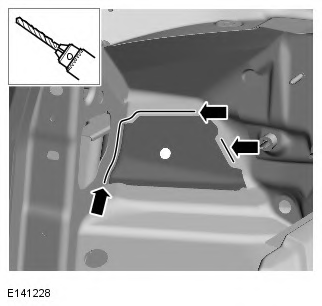
22. NOTE: The spot welds must be drilled from this side to enable the joint to be MIG plug welded on installation. Drill out the spot welds.
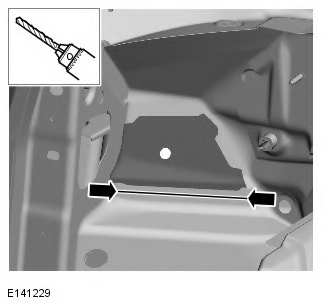
23. Drill out the spot welds.
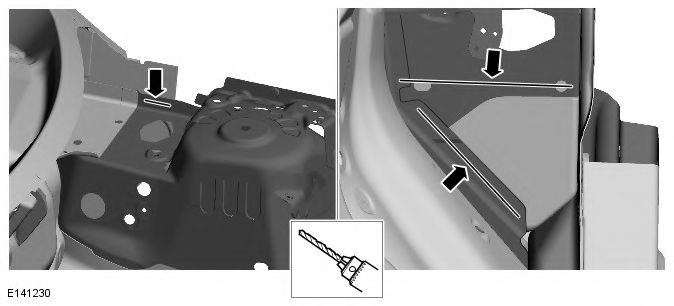
24. NOTE: Where there is no access to drill use a belt sander to sand down the spot welds in these areas. Drill out the spot welds.
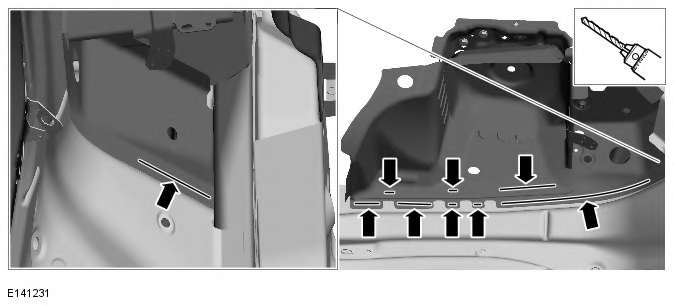
25. Separate the joints and remove the old panel.
Installation
1. Refer to the old panel for reference and prepare the new panel in the areas where it is not fully welded and spot weld.
2. NOTE: The drilled out spot welds must be replaced with MIG plug welds in the same quantities. Using the old panel for reference drill holes in the new panel ready for MIG plug welding.
3. Prepare the old and new panel joint surfaces.
4. Offer up the new panel and clamp into position. Check alignment, if correct, proceed to next step, if not, rectify and recheck before proceeding.
5. MIG Plug weld.
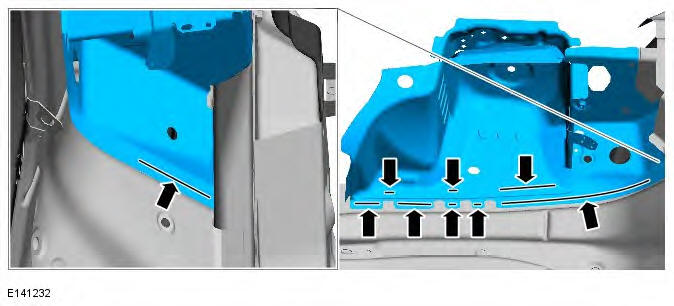
6. MIG Plug weld.
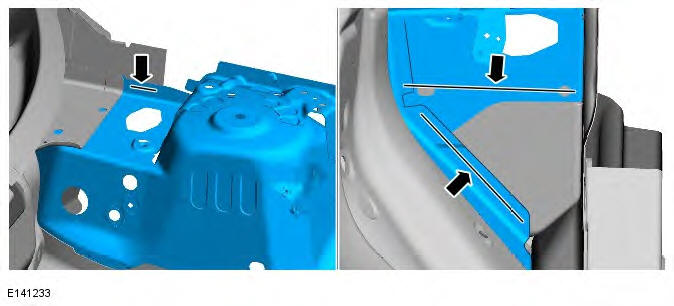
7. MIG Plug weld.
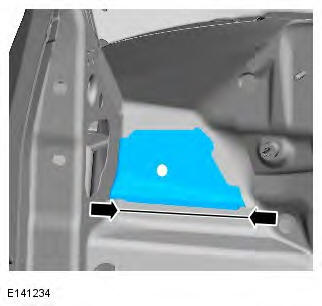
8. MIG Plug weld.
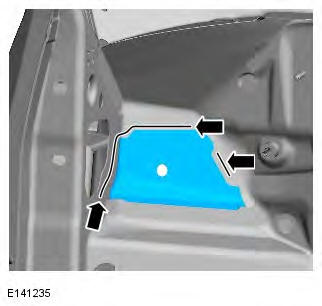
9. Dress all welded joints.
10. LH Only.
Prepare the new panel and install the weld studs in their original locations. The measurements provided in the graphic are to be used as a guide only, the components that are located/fixed to these weld studs must be offered up and cross checked for alignment prior to the installation of the weld studs to the new panel.
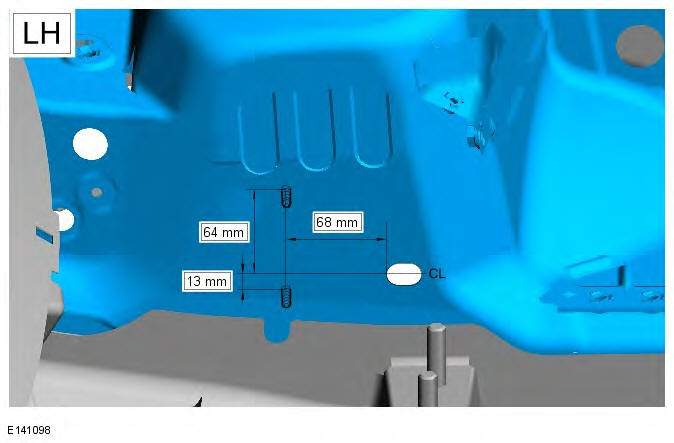
11. RH Only.
Prepare the new panel and install the weld studs in their original locations. The measurements provided in the graphic are to be used as a guide only, the components that are located/fixed to these weld studs must be offered up and cross checked for alignment prior to the installation of the weld studs to the new panel.
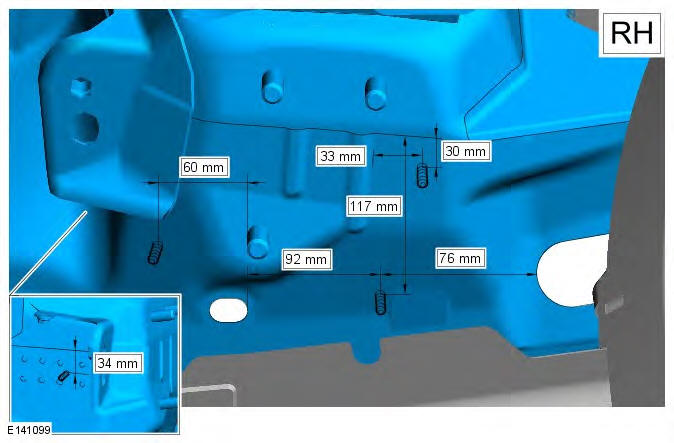
12. Apply a zinc rich primer to any bare metal surfaces at this stage.
13. NOTE: Make sure all underbody joints are sealed following this repair procedure
The installation of associated panels and mechanical components is the reverse of removal.

